What is a Mangle used for - squeezing water out of wet laundry
Mangles were heavy mechanical contraptions about four or five feet high with a handle that turned two rollers which squeezed out the water into a large bowl or tin bath underneath. Widely used terms nowadays are 'clothes mangle' and 'clothes wringer'. Wringer is surprising because 'wringing' means twisting, and no twisting is involved in mangling. Mangle was the only word used in the UK in the past.
____
Extracted from the memoirs of the webmaster's mother (1906-2002) and edited by the webmaster with further research and firsthand contributions from others
Before the arrival of spin dryers around the 1950s, all but the very poorest of households had a mangle. It was used on washday to remove the majority of the water from the wet clothes and sheets after each rinse.
Mangles description
Mangles were made of cast iron making them heavy and comberson and difficult to move around. They had a screw on top to adjust the distance between the rollers according to the thickness of the fabric. For blankets, for example, the screw was let out as far as possible.
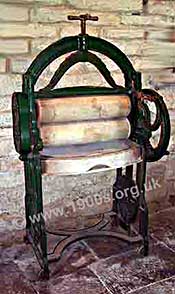
Old cast iron mangle for removing water from wet laundry
The legs were on wheels which could be clamped when the mangle was in use.
Storage
A mangle was so large and heavy and took up so much room, it was kept outside the back door with a sheet of tarpaulin over it to protect it from the weather. This was usual practice in the Victorian terraces where I grew up in the early 1900s.
Later in the 1940s when I was married, mangles were smaller and lighter. Mine fitted easily into the kitchen of my 1930s/1940s house.)
Use
On washdays in good weather the mangle could be used outside where it stood, but in bad weather it had to be rolled indoors.
After each rinse, every single item of the laundry had to be put through the rollers. Each one, separately, was placed between the rollers and as the handle was turned, the rollers rolled and fed the item through. The water dropped into a bowl or tin bath below. It was hard work turning the handle and every item was rinsed several times and put through the rollers again.
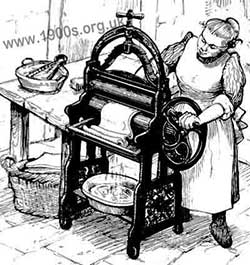
Sketch of a woman using a cast iron mangle
Small clothes like socks could go through the rollers as they were, but larger items had to be folded into strips which were narrow enough to go through the rollers. For sheets and blankets this folding was a two-person job, with one person at each end of the sheet or blanket, and care had to be taken to keep it off the floor. If no-one was available to help, the pegs on the clothes line could sometimes replace the second person.
When my brothers and I came home from school for our mid-day meal, mangling was still in progress on washdays. A lot of energy was needed for it, and I had to help by holding the sheets as straight as I could while my mother turned the handle.
When items had gone through the rollers, they almost looked as if they had been ironed already, but they were still quite damp and needed to be dried and ironed. Drying the wash and ironing are on separate pages.
Fingers trapped in rollers
It was by no means unusual for children to get their fingers caught in the rollers.
Fingers trapped in rollers of the clothes mangle was SERIOUS!
contributed by Ruth Summersides, family recollection
I never used to unplug my Hotpoint electric wringer machine because I had never-ending laundry. Then one Sunday morning while my husband and I were having a lie in, we heard a scream, galloped downstairs, two at a time, and found my daughter, aged 3, with her whole arm in the wringer.
The wringer automatically stopped and opened if the clothes were too thick to go through, but her little arm had not stopped it until it had gone far in. She had a greenstick fracture in two places. I’m happy to say she did recover without any ill effects but I lost 6 months off my life.
Damage to buttons from the clothes mangle
Buttons invariably chipped under the pressure of the rollers, even with the top adjustment loosened.
Perhaps it was understandable that women risked using the mangle on clothes with buttons, rather than having to wring the water out by hand or snip off the buttons and sew them on again afterwards. The result was chipped buttons.
Broken buttons on clothes
Note from the webmaster
In the 1940s, while I was growing up, it was not unusual to see people with broken buttons, almost certainly because someone had risked putting them through the mangle's rollers on washday.
Linen buttons and shank buttons: user friendly for clothes mangling
There were mangle-friendly buttons which avoided chipped buttons on clothes that were often washed.
One way which was particularly common on men's shirtes was buttons made of woven linen which wouldn't break under the pressure of the rollers.
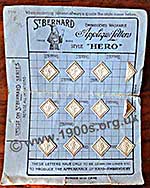
Card of square linen buttons as bought from a shop
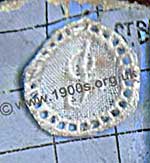
A round linen button. Linen buttons would pass safely through the rollers
Clothes like heavy overalls needed heavier buttons. The solution was to have buttons with metal shanks which, rather than being sewn in place, were poked through small holes and held in place at the back with studs or clips. The clips were rather like short hair grips.
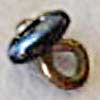
A shank button for thick fabrics, easily removed for washing and mangling and ironing using a special clip.
Then every time that the item was washed, the buttons were removed and then clipped back into place afterwards. The holes for the shanks were sewn just like regular button holes except that they were much smaller and round.
Once spin dryers came on the market, the type of button ceased to be a problem.
| sources | webmaster | contact |
Text and images are copyright
If you can add anything to this page or provide a photo, please contact me.



